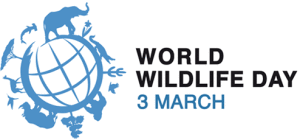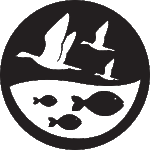World Wildlife Day , March 3 2017 
World Wildlife Day is celebrated on March 3 each year to celebrate all of the different plants and wild animals on Earth and raise awareness on the importance of conservation, highlight threatened or endangered species and connect individuals to action to do their part to protect wildlife. On March 3 in 1973, signatures completed the Convention on International Trade in Endangered Species of Wild Fauna and Flora (CITES). This year’s theme is ‘Listen to the Young Voices,’ encouraging young people around the world to find out what wildlife and conservation means to them, and what they can do to take action for the future of both wild animals and plants (World Wildlife Day, 2017).
Why is the Detroit River a significant wildlife area?
Prior to first European settlers in the Detroit River watershed, the area was abundant with fish, wildlife, coastal wetlands and unspoiled drinking water. The Detroit River ecosystem since then has significantly changed. Agriculture, intense urbanization, and industrialization led to a loss of 97% of the original wetlands and, consequently, the Detroit River suffered habitat and biodiversity loss. For this reason, among others, the river was designated as one of the original 43 Great Lakes Areas of Concern (AOC) in the Great Lakes Water Quality Agreement (GLWQA) in 1987 (Detroit River Canadian Cleanup, 2010, p. 1).
Despite the historical issues, the Detroit River ecosystem is recognized as one of the most biodiverse areas within the Great Lakes Basin, and one of the greatest rivers in North America. It is a connecting channel that links the Upper Great Lakes to the Lower Great Lakes, and is part of the Huron Erie Corridor. The resource provides is invaluable to millions of people living in both Canada and the United States who call it their ‘backyard,’ as well as home to many different species of plants and wildlife. Its ecological value provides purpose to those living in this area as it draws individuals outside to explore it and inevitably enhances the quality of life for those who acknowledge its value.
The Detroit River Canadian Cleanup (DRCC) implements the Remedial Action Plan (RAP) for the Canadian side of the Detroit River Area of Concern (DRCC, 2010, p. 4-5). Within the RAP, loss of fish and wildlife habitat and degradation of fish and wildlife populations are recognized as beneficial use impairments that require protection, restoration and enhancement of coastal wetlands, terrestrial and aquatic habitats to repair habitat for wildlife (DRCC, 2010, p. 3).
 |
 |
|
Degradation of Fish and Wildlife Populations |
Degradation of Fish and Wildlife Habitat |
How biodiverse is the Detroit River?
Lake Whitefish and Lake Sturgeon are spawning in the Detroit River again since a disappearance at the beginning of the 1900s. Improved water quality and habitat restoration have encouraged these species to come back to the river (DRCC, 2010, p. 34).
A partnership between the Michigan Department of Natural Resources, the U.S. Geological Survey and the Ontario Ministry of Natural Resources and Forestry formed in 2015 to conduct a full creel survey of the Detroit River. In total, anglers put in over 600,000 hours on the river and the majority of the recreational fisheries catch effort (54%) took place between April and May 2015. Over 500,000 White Bass, 156,000 Walleye, 192,000 Yellow Perch, 100,000 Smallmouth Bass, and 4,000 Muskellunge were caught from the Detroit River. For more information about the Detroit River Creel Survey, please review the DRCC’s 2015/16 Annual Report (DRCC, 2016, p. 6-7). It is estimated that over 65 species of fish use the Detroit River for mating, breeding and feeding (IAGLR, 2017). Other common fish to the Detroit River include: Pumpkinseed (aka Sunfish), Rock Bass, Smallmouth Bass, Whitefish, Lake Sturgeon, Black Crappie, Northern Pike and more (Michigan Department Health and Human Services, 2017, p. 12-13).
The Detroit River intersects two major flyways (Mississippi Flyway and Atlantic Flyway), and over 350 bird species and other migratory species have been recorded (including waterfowl, shorebirds, raptors, non-raptors, songbirds and butterflies). As the Detroit River is a major waterfowl migration corridor, 29 species of waterfowl are commonly found in the Detroit River. It is estimated that three million ducks, geese, swans and coots migrate annually through the region (DRCC, 2010, p. 35).
Coastal wetlands and shorelines within the Detroit River provide habitat and breeding sites for waterfowl such as American Black Duck, Canvasback, Common Merganser, Wood Duck, Mallard, Common Loon, Belted Kingfisher, Canada Geese, Trumpet Swan, Tundra Swan, American Woodcock and more. Other common species you might come across in a Detroit River wetland include: White Water Lily, Cattail, Reed Canary Grass, Canada Waterweed, American Bittern, Mallard, Green Frog, Tree Swallow, Great Blue Heron, Northern Leopard Frog, American Bullfrog, Marsh Marigold, and many different types dragonflies, damselflies, and butterflies.
There are multiple locations along the Detroit River where Bald Eagles are nesting, producing and raising young. The breeding population has increased significantly from early monitoring programs, suggesting that the health Detroit River has improved for the birds to sustain a stable population (DRCC, 2010, p. 35).
The Detroit River hosts the International Wildlife Refuge (DRIWF), which was signed into law in 2001 through the Detroit River International Wildlife Refuge Act, the first one in North America. This area is actively managed and supports multiple partnerships to achieve conservation success (U.S. Fish and Wildlife Service, 2017). To learn more, watch this short video by U.S. Fish and Wildlife Service about the DRIWF.
There are a variety of mammals who call the Detroit River home such as Raccoon, Striped Skunk, Opossum, White-Tailed Deer, Coyote, Gray Fox, Eastern Cottontail, Muskrat, Mink, Beaver as well as multiple mole and mice species.
What are some projects that have taken place in the Detroit River to address the two beneficial use impairments mentioned above?
- Lake Sturgeon habitat restoration at Fighting Island
- Windsor Riverfront shoreline stabilization and habitat enhancement (Elm Avenue to Caron Avenue, Langlois to Moy Avenue)
- Detroit River and River Canard stewardship initiative
- Fort Malden shoreline stabilization and habitat enhancement
- McKee Park improvements and Lake Sturgeon habitat creation
- Upper Canard River low flow augmentation
- C. Row Expressway cloverleaf naturalization
- Goose Bay shoreline naturalization habitat enhancement
- Canard marsh improvements and Turkey Island enhancement
- Little River rehabilitation
- Turkey Creek channel improvements and water quality assessments
- City of Windsor Candidate Natural Heritage Site Assessment (CNHS)
- Downspout Disconnection Program with the City of Windsor
- Household Mercury and Chemical Waste Collection
- Community organizations such as the Detroit River Canadian Cleanup, Essex Region Conservation Authority, the Essex County Field Naturalists Club, Little River Enhancement Group, Friends of Canard River, Friends of Turkey Creek Watershed have hosted cleanups and plantings in the Detroit River and three sub-watersheds to improve habitat quantity and quality.
For more detailed information for the projects listed above, and to access the complete list of projects from 1998 to 2008, please review the Detroit River Remedial Action Plan Stage 2 (2010) document from pages 82 to 118 (DRCC, 2010, p. 82-118).
As the international community celebrates World Wildlife Day on March 3 2017, it is crucial to remember that action starts with the individual. What can you do to protect wildlife along the Detroit River?
- Always dispose solid and liquid hazardous and non-hazardous waste properly. It is important to be environmentally responsible and take care of the Detroit River system! Visit Windsor Essex Solid Waste Authority’s website http://www.ewswa.org for information regarding waste disposal in Essex region. This includes not pouring anything down the storm drain.
- If you see illegal dumping or a spill in and along the water channel, report it using any of the following ways:
- 1-800-265-7672 (area code 519 only)
- Public Information Centre: 1-800-565-4923
- Spills Action Centre: 1-800-268-6060
- Pollution Hotline: 1-866-663-8477
- Watch the DRCC videos Wastewater: Where does it go? and 1, 2, and TP, that’s it! Visit our site: ca/media.
- Avoid water activities such as washing your vehicle in areas where the wastewater will flow into the storm sewer. Washing on a lawn or gravel surface allows wastewater to be absorbed by soil below
- Keep the storm sewers clean and void of litter and debris during heavy rain events. Rainwater is the only liquid that should go down the storm sewers.
- Disconnecting downspouts frees up capacity in the sewers during a storm event as they allow water to flow across the lawn. Also installing a rain barrel will collect this water during a storm and can be used in your garden on dry days. Both these actions help reduce the volume of sewage and or runoff that can end up in the Detroit River untreated. Check out the City of Windsor’s Downspout (Eavestrough) Disconnection page for more information.
- Check out the DRCC’s Publications page to download copies of: Detroit River Watershed Tour information, A Guide to Native Plants, How to Create a Rain Garden, Go Natural: Pull Don’t Spray and Protecting our River from your Household Chemical Waste.
- Get involved with community organizations such as the Detroit River Canadian Cleanup, Essex Region Conservation Authority, the Essex County Field Naturalists Club, Little River Enhancement Group, Friends of Canard River, Friends of Turkey Creek Watershed who are actively engaged in projects that improve habitat within the Detroit River watershed.
- Sign up for the DRCC Newsletter, The Current to keep up to date on events in the community
Detroit River Wildlife Gallery
References
Detroit River Canadian Cleanup. (2016). Annual review 2015 & 2016. Results for the Detroit River creel survey. p. 6-7. Retrieved from http://detroitriver.ca/wp-content/uploads/2016/10/DRCC_AR_2016_web.pdf
Green N.D., Cargnelli L., Briggs T., Drouin. R, Child M., Esbjerg J., Valiante M., Henderson T., McGregor D., and D. Munro, eds. (2010). Detroit River Canadian remedial action plan: stage 2 report. Detroit River Canadian Cleanup, Publication No. 1, Essex, Ontario, Canada. Retrieved from: http://detroitriver.ca/wp-content/uploads/2015/05/Detroit_River_Canadian_Stage_2_Remedial_Action_Plan_FINAL_DIGITAL.pdf
International Association for Great Lakes Research. (2017). Conserving Detroit River habitats. Retrieved from: http://iaglr.org/scipolicy/issues/detroithabitat.php
Michigan Department of Health and Human Services. (2017). Eat safe fish guide. p. 12-13. Retrieved from: https://www.michigan.gov/documents/mdch/MDCH_EAT_SAFE_FISH_GUIDE_-_SOUTHEAST_MI_WEB_455358_7.pdf
U.S. Fish and Wildlife Service. (2017). About the refuge. Retrieved from https://www.fws.gov/refuge/Detroit_River/about.html.
World Wildlife Day, 3 March. (2017). About. Retrieved from http://wildlifeday.org/about


